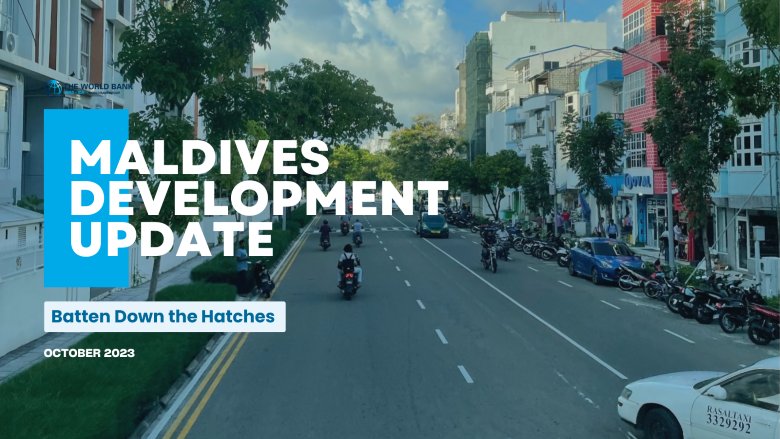The Maldives Development Update (MDU) has two main goals. First, it takes the pulse of the Maldivian economy by providing key developments over the past 12 months. Placing these in a global context, and based on these recent developments, it analyzes the outlook over the medium term. Second, every other edition of the MDU provides a more in-depth investigation of selected economic and policy issues. It has a wide audience including policymakers, policy analysts from think tanks or non-governmental organizations, and business and financial sector professionals interested in Maldives’ economic development.

Click here to download the latest Maldives Development Update (October, 2023).
RECENT ECONOMIC DEVELOPMENTS
Maldivian economy continued to expand in Q1 2023 by 5.5 percent year-on-year, surpassing pre-pandemic levels. This growth is expected to reduce poverty rates below 2019 levels. Tourist arrivals also increased, reaching 1.2 million by August 2023 and projected to be 1.9 million in 2023, a 13.8 percent increase compared to 2022.
However, the economy faced challenges, including rising inflation of 3.5 percent year-on-year in H1 2023, driven by higher global commodity prices and the Goods and Services Tax (GST) increase in January 2023. Inflation was particularly high in the food, transport, health, and restaurant services sectors.
The current account deficit doubled to 16.7 percent of GDP in 2022 due to expensive oil imports and capital imports for large projects. This, along with external debt repayments, put pressure on gross reserves, which decreased from US$790 million in January to US$594.1 million in July.
Despite proposed subsidy reforms and capital spending cuts not being implemented, government spending increased in 2023. Higher tax collections due to strong growth and increased tourism GST partially offset this increase. As a result, the fiscal deficit declined from 14.4 percent of GDP in 2022 to around 11 percent in May 2023. The Monetary Authority of Maldives (MMA) also increased its exposure to the government, with 52 percent of its total financial assets allocated to government bonds in mid-2023, up from 47.3 percent in 2022.
CHALLENGES
In the first half of 2023, Maldives' tourism industry remained strong, with arrivals from Russia unaffected by the Russian invasion of Ukraine. Reopening the Chinese market early in the year helped compensate for fewer tourists from India and Gulf countries, while European arrivals remained high, providing employment opportunities, especially for the impoverished population.
However, Maldives faces structural challenges due to heavy dependence on tourism and limited diversification. The country's import-heavy economy is grappling with external pressures and inflation caused by high global commodity prices, affecting public finances due to government subsidies aimed at curbing domestic price increases. High capital spending, public debt, a growing wage bill, and costly health insurance schemes further compound these challenges.
To address these issues, targeted austerity measures could help protect vulnerable households, especially in the atolls, where the majority of the poor reside. Maldives' welfare model includes universal access to basic health and education services, pensions, health insurance, and income support programs, which contribute significantly to the income of poorer households. Additional welfare challenges include unequal access to economic opportunities between Male and the atolls, higher vulnerability among the self-employed, and overcrowding affecting poorer urban households.
While infrastructure investments have promoted growth and improved living standards since 2016, financing these projects through non-concessional sources has increased debt vulnerabilities. Despite the higher cost of external borrowing, the government continued to rely on foreign financing for infrastructure investments in 2023, along with domestic borrowing to support recurrent spending. This has raised concerns about the financial sector's exposure to the government, and both the debt stock and debt servicing risks are expected to remain high.
OUTLOOK
The medium-term economic outlook for the country is positive, with an average projected growth rate of 5.6 percent, mainly driven by a strong performance in the tourism sector. The return of Chinese tourists and increased arrivals from various markets are expected to sustain this growth, aided by airport expansion, a diverse tourism sector, and investments in new resorts.
However, fiscal challenges persist despite recent gains in GST collections. Without significant fiscal reforms, continued high levels of spending will offset any improvements in the fiscal balance, resulting in persistently high public debt. To address these issues, a more substantial fiscal adjustment is needed, including reducing untargeted subsidies and improving public investment management. Targeted transfers can help mitigate the impact of subsidy reforms on the poor.
Inflation is expected to remain above historical averages due to high consumption, global commodity prices, and the GST rate hike. Careful design of future subsidy reforms is necessary to prevent worsening poverty as households may bear the brunt of higher prices.
The current account deficit is likely to stay elevated due to commodity price pressures and ongoing capital imports for infrastructure projects. Volatile oil prices and rising external financing needs, including debt servicing, will continue to strain official reserves.
There are ongoing downside risks, including the potential impact of a global economic slowdown on tourism and further widening of the current account deficit, which could worsen reserve pressures. The government also faces substantial external debt servicing payments in the coming years amid tighter global financing conditions. On a positive note, the global tourism sector outlook is strong, and with robust economic growth, poverty rates are expected to decline.
Last Updated: Oct 03, 2023
Maldives is expecting a strong growth of 6.5% this year. However, to ensure a more resilient economy going forward, and to build on the recent reforms, prudent debt management and a fiscal adjustment with strengthened investment planning are needed in the context of tightened global conditions and already elevated fiscal deficits. While tourism will remain a primary engine of growth, Maldives stands to benefit by promoting more eco-tourism and fisheries development, prioritizing limited infrastructure financing for remote areas, and encouraging more private sector investment in such a way that growth is inclusive, greener and resilient to climate and other shocks.

PAST ISSUES
CONTACTS
Richard Walker
Senior Country Economist | rwalker3@worldbank.org
Erdem Atas
Country Economist and Resident Coordinator | eatas@worldbank.org
Dilinika Peiris
External Affairs Officer | dpeiris@worldbank.org

